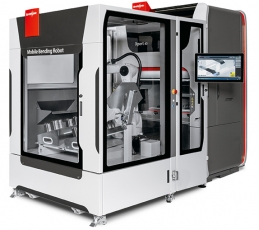 Automating bending operations when production demands are high provides much-needed flexibility for fabrication shops. As productivity has increased due to the introduction of high-speed Fiber laser cutting systems, so has the demand for additional bending capacity. Offline programming capabilities have surely freed up additional press brake capacity, but there is still a need for further increases in capacity in most cases. One of the biggest opportunities with gaining additional capacity is with press brake automation.
Automating bending operations when production demands are high provides much-needed flexibility for fabrication shops. As productivity has increased due to the introduction of high-speed Fiber laser cutting systems, so has the demand for additional bending capacity. Offline programming capabilities have surely freed up additional press brake capacity, but there is still a need for further increases in capacity in most cases. One of the biggest opportunities with gaining additional capacity is with press brake automation.
Automating for Reduced Set-up Time
For most small lot sizes automation would not make sense as the set-up time is where most of the time is spent for most jobs. Reducing the setup time for small lot sizes requires automating the tool loading process, which in turn enables the operator to multi-task and reduces the overall setup time by as much as 70%. While the robot automation is selecting the correct tooling for each job as programs are loaded, operators can then move material stacks and also enter information into a job tracking software and other related tasks simultaneously.
Automating for Large Parts
For larger lot sizes the addition of a robot to perform bending operations is essential, especially when the parts are large and require a lot of handling for bending. This need is highly evident when it requires multiple operators to handle the parts over long periods of time. Not only does it require double the labor, but the production efficiency over the course of a working shift will decrease as fatigue begins to set in. There is also the increased risk of injury when handling large parts for long periods of time.
Automating for Lot Size and Maintaining the Pace
Press brake automation comes in many different sizes and equally for many different applications. Many of the lighter gauge parts that require bending automation do so not only for the larger lot sizes but also for keeping pace with new high-speed press brakes. Bending speeds of one inch per second are not unusual for these types of brakes and the level of speed and endurance required from the operator is also demanding.
Opportunity and Flexibility
Yet another opportunity derived from press brake automation is the ability of the systems to operate in off-shifts to increase throughput. Utilizing automation provides the flexibility to operate a press brake in the off-shift and fully utilize the additional bending capacity that is created with press brake automation. New mobile bending automation systems allow the press brake to be operated manually during working shifts and with a quick addition of a mobile robot bending cell, completely automated providing the ultimate flexibility with bending operations.
By Frank Arteaga, Head of Product Marketing, NAFTA Region
Bystronic Inc., Elgin, IL – Voice.bystronic@bystronic.com
